Witchcraft
| Part of a series on |
| Witchcraft |
|---|
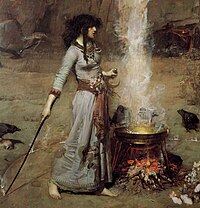 |
| Part of a series on |
| Magic |
|---|
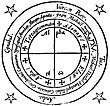 |
Witchcraft, as most commonly understood in both historical and present-day communities, is the use of alleged supernatural powers of magic. A witch is a practitioner of witchcraft. Traditionally, "witchcraft" means the use of magic or supernatural powers to inflict harm or misfortune on others, and this remains the most common and widespread meaning.[1]: ix [2] According to Encyclopedia Britannica, "Witchcraft thus defined exists more in the imagination of contemporaries than in any objective reality. Yet this stereotype has a long history and has constituted for many cultures a viable explanation of evil in the world".[3] The belief in witchcraft has been found in a great number of societies worldwide. Anthropologists have applied the English term "witchcraft" to similar beliefs in occult practices in many different cultures, and societies that have adopted the English language have often internalised the term.[4][2][5]
In
Many indigenous belief systems that include the concept of witchcraft likewise define witches as malevolent, and seek healers and medicine people for protection against witchcraft.[10][11] Some African and Melanesian peoples believe witches are driven by an evil spirit or substance inside them. Modern witch-hunting takes place in parts of Africa and Asia.
Today, followers of certain types of modern paganism self-identify as witches and use the term witchcraft for their beliefs and practices.[12][13][14] Other neo-pagans avoid the term due to its negative connotations.[15]
Concept

The concept of witchcraft and the belief in its existence have persisted throughout recorded history. According to the
The most common meaning of "witchcraft" worldwide is the use of harmful magic.[1]: 3–4 Belief in malevolent magic has been found in cultures worldwide, regardless of development.[4][17]: xiii Most societies have feared an ability by some individuals to cause supernatural harm and misfortune to others. This may come from mankind's tendency "to want to assign occurrences of remarkable good or bad luck to agency, either human or superhuman".[1]: 10 Historians and anthropologists see the concept of "witchcraft" as one of the ways humans have tried to explain strange misfortune.[1]: 10 [18] Some cultures have feared witchcraft much less than others, because they tend to have other explanations for strange misfortune.[1]: 10 For example, the Gaels of Ireland and the Scottish Highlands historically held a strong belief in fairy folk, who could cause supernatural harm, and witch-hunting was very rare in these regions compared to other regions of the British Isles.[1]: 245
Historian Ronald Hutton outlined five key characteristics ascribed to witches and witchcraft by most cultures that believe in this concept: the use of magic to cause harm or misfortune to others; it was used by the witch against their own community; powers of witchcraft were believed to have been acquired through inheritance or initiation; it was seen as immoral and often thought to involve communion with evil beings; and witchcraft could be thwarted by defensive magic, persuasion, intimidation or physical punishment of the alleged witch.[1]: 3–4 [a]
It is commonly believed that witches use objects, words, and gestures to cause supernatural harm or that they simply have an innate power to do so. Hutton notes that both kinds of practitioners are often believed to exist in the same culture and that the two often overlap, in that someone with an inborn power could wield that power through material objects.[1]: 19–22
One of the most influential works on witchcraft and concepts of magic was E. E. Evans-Pritchard's Witchcraft, Oracles, and Magic Among the Azande, a study of Azande witchcraft beliefs published in 1937. This provided definitions for witchcraft which became a convention in anthropology.[18] However, some researchers argue that the general adoption of Evans-Pritchard's definitions constrained discussion of witchcraft beliefs, and even broader discussion of magic and religion, in ways that his work does not support.[19] Evans-Pritchard reserved the term "witchcraft" for the actions of those who inflict harm by their inborn power and used "sorcery" for those who needed tools to do so.[20] Historians found these definitions difficult to apply to European witchcraft, where witches were believed to use physical techniques, as well as some who were believed to cause harm by thought alone.[2]: 464–465 [21] The distinction "has now largely been abandoned, although some anthropologists still sometimes find it relevant to the particular societies with which they are concerned".[1]: 19–22
While most cultures believe witchcraft to be something willful, some Indigenous peoples in Africa and Melanesia believe witches have a substance or an evil spirit in their bodies that drives them to do harm.[1]: 19–22 However, such substances are described in other accounts as being able to act on their own while the witch is sleeping or unaware.[19] The Dobu people believe women work harmful magic in their sleep while men work it while awake.[1]: 18-19 Further, in cultures where substances within the body are believed to grant supernatural powers, the substance may be good, bad, or morally neutral.[22][23] Hutton draws a distinction between those who unwittingly cast the evil eye and those who deliberately do so, describing only the latter as witches.[1]: 10
The universal or cross-cultural validity of these terms are debated.[18] Hutton states:
[Malevolent magic] is, however, only one current usage of the word. In fact, Anglo-American senses of it now take at least four different forms, although the one discussed above seems still to be the most widespread and frequent. The others define the witch figure as any person who uses magic ... or as the practitioner of nature-based Pagan religion; or as a symbol of independent female authority and resistance to male domination. All have validity in the present.[1]: 10
Dr. Fiona Bowie notes that the terms "witchcraft" and "witch" are used differently by scholars and the general public in at least four different ways that must be treated separately.[18] Neopagan writer Isaac Bonewits proposed dividing witches into even more distinct types including, but not limited to: Neopagan, Feminist, Neogothic, Neoclassical, Classical, Family Traditions, Immigrant Traditions, and Ethnic.[24]: 65–68
Etymology
The word is over a thousand years old: Old English formed the compound wiccecræft from wicce ('witch') and cræft ('craft').[25] The masculine form was wicca ('male sorcerer').[26]
According to the
Another Old English word for 'witch' was hægtes or hægtesse, which became the modern English word "hag" and is linked to the word "hex". In most other Germanic languages, their word for 'witch' comes from the same root as these; for example German Hexe and Dutch heks.[28]
In colloquial modern English, the word witch is particularly used for women.[29] A male practitioner of magic or witchcraft is more commonly called a 'wizard', or sometimes, 'warlock'. When the word witch is used to refer to a member of a neo-pagan tradition or religion (such as Wicca), it can refer to a person of any gender.[citation needed]
Beliefs about practices
Witches are commonly believed to cast
A common belief in cultures worldwide is that witches tend to use something from their target's body to work magic against them; for example hair, nail clippings, clothing, or bodily waste. Such beliefs are found in Europe, Africa, South Asia, Polynesia, Melanesia, and North America.[1]: 19-22 Another widespread belief among Indigenous peoples in Africa and North America is that witches cause harm by introducing cursed magical objects into their victim's body; such as small bones or ashes.[1]: 19-22 James George Frazer described this kind of magic as imitative.[b]
In some cultures, witches are believed to use human body parts in magic,[1]: 19-22 and they are commonly believed to murder children for this purpose. In Europe, "cases in which women did undoubtedly kill their children, because of what today would be called postpartum psychosis, were often interpreted as yielding to diabolical temptation".[35]
Witches are believed to work in secret, sometimes alone and sometimes with other witches. Hutton writes: "Across most of the world, witches have been thought to gather at night, when normal humans are inactive, and also at their most vulnerable in sleep".[1]: 19-22 In most cultures, witches at these gatherings are thought to transgress social norms by engaging in cannibalism, incest and open nudity.[1]: 19-22
Witches around the world commonly have associations with animals.[1]: 264-277 Rodney Needham identified this as a defining feature of the witch archetype.[36] In some parts of the world, it is believed witches can shapeshift into animals,[1]: 264 or that the witch's spirit travels apart from their body and takes an animal form, an activity often associated with shamanism.[1]: 264 Another widespread belief is that witches have an animal helper.[1]: 264 In English these are often called "familiars", and meant an evil spirit or demon that had taken an animal form.[1]: 264 As researchers examined traditions in other regions, they widened the term to servant spirit-animals which are described as a part of the witch's own soul.[1]: 269
Necromancy is the practice of conjuring the spirits of the dead for divination or prophecy, although the term has also been applied to raising the dead for other purposes. The biblical Witch of Endor performed it (1 Samuel 28th chapter), and it is among the witchcraft practices condemned by Ælfric of Eynsham:[37][38][39] "Witches still go to cross-roads and to heathen burials with their delusive magic and call to the devil; and he comes to them in the likeness of the man that is buried there, as if he arises from death."[40]
Witchcraft and folk healers

Most societies that have believed in harmful or black magic have also believed in helpful magic. Some have called it white magic, at least in more recent times.[1]: 24-25 Where belief in harmful magic exists, its use is typically forbidden by law as well as hated and feared by the general populace, while helpful "white" or apotropaic magic is tolerated or even accepted wholesale by the population, even if the orthodox establishment opposes it.[41]: 203
In these societies, practitioners of helpful magic, usually known as cunning folk, have traditionally[timeframe?] provided services such as breaking the effects of witchcraft, healing, divination, finding lost or stolen goods, and love magic.[1]: x-xi In Britain, and some other parts of Europe, they were commonly known as cunning folk or wise people.[1]: x-xi Alan McFarlane wrote that while cunning folk is the usual name, some are also known as 'blessers' or 'wizards', but might also be known as 'white', 'good', or 'unbinding witches'.[42] Historian Owen Davies says the term "white witch" was rarely used before the 20th century.[7]: xiii Ronald Hutton uses the general term "service magicians".[1]: x-xi Often these people were involved in identifying alleged witches.[1]: 24-25
Such helpful magic-workers "were normally contrasted with the witch who practiced maleficium—that is, magic used for harmful ends".[43]: 27-28 In the early years of the witch hunts "the cunning folk were widely tolerated by church, state and general populace".[43]: 27-28 Some of the more hostile churchmen and secular authorities tried to smear folk-healers and magic-workers by falsely branding them 'witches' and associating them with harmful 'witchcraft',[1]: x-xi but generally the masses did not accept this and continued to make use of their services.[44] The English MP and skeptic Reginald Scot sought to disprove magic and witchcraft, writing in The Discoverie of Witchcraft (1584), "At this day, it is indifferent to say in the English tongue, 'she is a witch' or 'she is a wise woman'".[45] Historian Keith Thomas adds "Nevertheless, it is possible to isolate that kind of 'witchcraft' which involved the employment (or presumed employment) of some occult means of doing harm to other people in a way which was generally disapproved of. In this sense the belief in witchcraft can be defined as the attribution of misfortune to occult human agency".[2]: 519
: 123Witch-hunts and thwarting witchcraft
The examples and perspective in this section may not represent a worldwide view of the subject. (August 2023) |

Societies that believed in witchcraft also believed that it could be thwarted in various ways. One common way was to use
Accusations of witchcraft
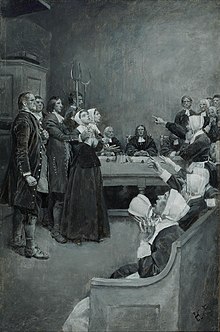
Throughout the world, accusations of witchcraft are often linked to social and economic tensions. Females are most often accused, but in some cultures it is mostly males. In many societies, accusations are directed mainly against the elderly, but in others age is not a factor, and in some cultures it is mainly adolescents who are accused.[1]: 15
Éva Pócs writes that reasons for accusations of witchcraft fall into four general categories. The first three of which were proposed by Richard Kieckhefer, and the fourth added by Christina Larner:[47]: 9-10
- A person was caught in the act of positive or negative sorcery
- A well-meaning sorcerer or healer lost their clients' or the authorities' trust
- A person did nothing more than gain the enmity of their neighbors
- A person was reputed to be a witch and surrounded with an aura of witch-beliefs or occultism.
Modern witch-hunts
Witch-hunts, scapegoating, and the shunning or murder of suspected witches still occurs.[50] Many cultures worldwide continue to have a belief in the concept of "witchcraft" or malevolent magic.[17] Apart from
Witchcraft-related violence is often discussed as a serious issue in the broader context of violence against women.[54][55][56][57][58] In Tanzania, an estimated 500 older women are murdered each year following accusations of witchcraft or accusations of being a witch, according to a 2014 World Health Organization report.[59]
Children who live in some regions of the world, such as parts of Africa, are also vulnerable to violence that is related to witchcraft accusations.[60][61][62][63] Such incidents have also occurred in immigrant communities in the UK, including the much publicized case of the murder of Victoria Climbié.[64][65]
Religious perspectives
Ancient Mesopotamian religion
Working magic was widely accepted and deeply integrated into the religion and the wider Mesopotamian society.[1]: 49 According to Tzvi Abusch, the early stages of the development of witchcraft (ipšū or kišpū[66]) in ancient Mesopotamia were "comparable to the archaic shamanistic stage of European witchcraft".[67]: 65–66 In this early stage, witches were not necessarily considered evil, but took white and black forms and could help others using a combination of magical and medical knowledge.[67]: 65–66 They generally lived in rural areas and sometimes exhibited ecstatic behavior,[67]: 65–66 which was more usually associated with the ašipu (exorcist), whose main function at this stage of development was to battle non-human supernatural forces.[67]: 65–66
In ancient Mesopotamian religion, witches (m. kaššāpu, f. kaššāptu, from kašāpu ['to bewitch'][66]) eventually[when?] came to be "regarded as an anti-social and illegitimate practitioner of destructive magic ... whose activities were motivated by malice and evil intent and who was opposed by the ašipu, an exorcist or incantation-priest",[67]: 65–66 who were predominantly male representatives of the official state religion.[67] The individuals mentioned in records of Mesopotamian society as witches tended to be those of low status who were weak or otherwise marginalized, including women, foreigners, actors, and peddlers.[1]: 49
By the time of the Code of Hammurabi (about 2000 BC), the use of magic to harm others without justification was subject to legal repercussions:
If a man has put a spell upon another man and it is not justified, he upon whom the spell is laid shall go to the
holy river; into the holy river shall he plunge. If the holy river overcome him and he is drowned, the man who put the spell upon him shall take possession of his house. If the holy river declares him innocent and he remains unharmed the man who laid the spell shall be put to death. He that plunged into the river shall take possession of the house of him who laid the spell upon him.[68][c]
The ašipu, in their continued efforts to suppress witchcraft,[67] developed an Akkadian anti-witchcraft ritual, the Maqlû, probably composed in the early first millennium BC.[70]
Confucianism
During the reign of
One notable event related to the suppression of shamanism occurred in 91 BCE, when Emperor Wu issued an edict that banned a range of "heterodox" practices, including shamanistic rituals and divination, in favor of Confucianism. The primary target of these measures was the
Emperor Wu's suppression of shamanism was part of a larger effort to centralize power, promote Confucian ethics, and standardize cultural practices. While the ban on shamanistic practices did impact certain communities and religious groups, these measures were not universally applied across the vast territory of the empire. Local variations and practices persisted in some regions despite imperial edicts.[71]
The historical record from that time is limited, and our understanding of these events can be influenced by the perspectives of the Confucian scholars and officials who documented them. As a result, there might be some variations in the interpretation of the exact nature and extent of the expulsion of shamans and other religious practitioners during Emperor Wu's reign.[71]
Abrahamic religions
Witchcraft's historical evolution in the Middle East reveals a multi-phase journey influenced by culture, spirituality, and societal norms. Ancient witchcraft in the Near East intertwined mysticism with nature through rituals and incantations aligned with local beliefs. In ancient Judaism, magic had a complex relationship, with some forms accepted due to mysticism[72] while others were considered heretical.[69] The medieval Middle East experienced shifting perceptions of witchcraft under Islamic and Christian influences, sometimes revered for healing and other times condemned as heresy.
Jewish
Jewish attitudes toward witchcraft were rooted in its association with
Christian
Historically, the
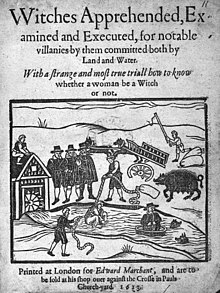
In
The Malleus Maleficarum (Latin for 'Hammer of The Witches') was a witch-hunting manual written in 1486 by two German monks, Heinrich Kramer and Jacob Sprenger. It was used by both Catholics and Protestants[81] for several hundred years, outlining how to identify a witch, what makes a woman more likely than a man to be a witch, how to put a witch on trial, and how to punish a witch. The book defines a witch as evil and typically female. It became the handbook for secular courts throughout Europe, but was not used by the Inquisition, which even cautioned against relying on it.[82] It was the most sold book in Europe for over 100 years, after the Bible.[83]
Islamic
Islamic perspectives on magic encompass a wide range of practices,[84] with belief in black magic and the evil eye coexisting alongside strict prohibitions against its practice.[85] The Quran acknowledges the existence of magic and seeks protection from its harm. Islam's stance is against the practice of magic, considering it forbidden, and emphasizes divine miracles rather than magic or witchcraft.[86] The historical continuity of witchcraft in the Middle East underlines the complex interaction between spiritual beliefs and societal norms across different cultures and epochs.
Modern paganism
During the 20th century, interest in witchcraft rose in English-speaking and European countries. From the 1920s, Margaret Murray popularized the 'witch-cult hypothesis': the idea that those persecuted as 'witches' in early modern Europe were followers of a benevolent pagan religion that had survived the Christianization of Europe. This has been discredited by further historical research.[24]: 45–47, 84–85 [1]: 121 [87][88][89]
From the 1930s,
Regional perspectives
This section should specify the language of its non-English content, using {{lang}}, {{transliteration}} for transliterated languages, and {{IPA}} for phonetic transcriptions, with an appropriate ISO 639 code. Wikipedia's multilingual support templates may also be used. (August 2021) |

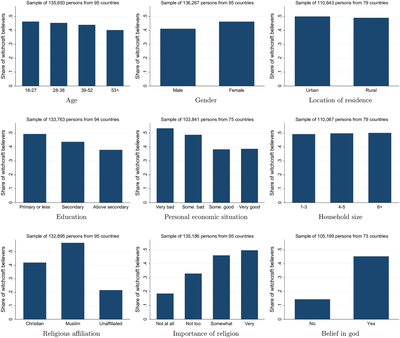
A 2022 study found that belief in witchcraft, as in the use of malevolent magic or powers, is still widespread in some parts of the world. It found that belief in witchcraft varied from 9% of people in some countries to 90% in others, and was linked to cultural and socioeconomic factors. Stronger belief in witchcraft correlated with poorer economic development, weak institutions, lower levels of education, lower life expectancy, lower life satisfaction, and high religiosity.[93][92]
It contrasted two hypotheses about future changes in witchcraft belief:[92]
- witchcraft beliefs should decline "in the process of development due to improved security and health, lower exposure to shocks, spread of education and scientific approach to explaining life events" according to standard modernization theory
- "some aspects of development, namely rising inequality, globalization, technological change, and migration, may instead revive witchcraft beliefs by disrupting established social order" according to literature largely inspired by observations from Sub-Saharan Africa.
Africa
African witchcraft encompasses various beliefs and practices. These beliefs often play a significant role in shaping social dynamics and can influence how communities address challenges and seek spiritual assistance. Much of what witchcraft represents in Africa has been susceptible to misunderstandings and confusion, thanks in no small part to a tendency among western scholars since the time of the now largely discredited Margaret Murray to approach the subject through a comparative lens vis-a-vis European witchcraft.[94]
While some colonialists tried to eradicate witch hunting by introducing legislation to prohibit accusations of witchcraft, some of the countries where this was the case have formally recognized the existence of witchcraft via the law. This has produced an environment that encourages persecution of suspected witches.[95]
In
In
Lastly, in
In parts of Africa, beliefs about illness being caused by witchcraft continue to fuel suspicion of modern medicine, with serious
Americas
North America
The views of witchcraft in North America have evolved through an interlinking history of cultural beliefs and interactions. These forces contribute to complex and evolving views of witchcraft. Today, North America hosts a diverse array of beliefs about witchcraft.[109][110]
The term witchcraft arrived with
The influences on Witchcraft in Latin America impacted North American views both directly and indirectly, including the diaspora of African witchcraft beliefs through the slave trade[115][116][110] and suppressed Indigenous cultures adopting the term for their own cultural practices.[117] Neopagan witchcraft practices such as Wicca then emerged in the mid-20th century.[109][110]
Latin America
When Franciscan friars from New Spain arrived in the Americas in 1524, they introduced Diabolism—belief in the Christian Devil—to the Indigenous peoples of the Americas.[118] Bartolomé de las Casas believed that human sacrifice was not diabolic, in fact far off from it, and was a natural result of religious expression.[118] Mexican Indians gladly took in the belief of Diabolism and still managed to keep their belief in creator-destroyer deities.[119]
Witchcraft was an important part of the social and cultural history of late-Colonial Mexico, during the Mexican Inquisition. Spanish Inquisitors viewed witchcraft as a problem that could be cured simply through confession. Yet, as anthropologist Ruth Behar writes, witchcraft, not only in Mexico but in Latin America in general, was a "conjecture of sexuality, witchcraft, and religion, in which Spanish, indigenous, and African cultures converged."[120] Furthermore, witchcraft in Mexico generally required an interethnic and interclass network of witches.[121] Yet, according to anthropology professor Laura Lewis, witchcraft in colonial Mexico ultimately represented an "affirmation of hegemony" for women, Indians, and especially Indian women over their white male counterparts as a result of the casta system.[122]
The presence of the witch is a constant in the
Asia
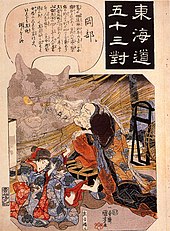
Asian witchcraft encompasses various types of witchcraft practices across Asia. In ancient times, magic played a significant role in societies such as ancient Egypt and Babylonia, as evidenced by historical records. In the Middle East, references to magic can be found in the Torah, where witchcraft is condemned due to its association with belief in magic.
In
Overall, witchcraft beliefs and practices in Asia vary widely across cultures, reflecting historical, religious, and social contexts.
Middle East
The practice of witchcraft in southwest Asia, sometimes referred to as the
Europe
This section needs additional citations for verification. (October 2023) |

European witchcraft is a multifaceted historical and cultural phenomenon that unfolded over centuries, leaving a mark on the continent's social, religious, and legal landscapes. The roots of European witchcraft trace back to
One pivotal text that shaped the witch-hunts was the
The Tsardom of Russia also experienced its own iteration of witchcraft trials during the 17th century. Witches were often accused of practicing sorcery and engaging in supernatural activities, leading to their excommunication and execution. The blending of ecclesiastical and secular jurisdictions in Russia's approach to witchcraft trials highlighted the intertwined nature of religious and political power during that time. As the 17th century progressed, the fear of witches shifted from mere superstition to a tool for political manipulation, with accusations used to target individuals who posed threats to the ruling elite.
Since the 1940s,
Ancient Roman world
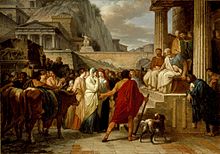
During the
The Classical Latin word veneficium meant both poisoning and causing harm by magic (such as magic potions), although ancient people would not have distinguished between the two.[1]: 59-66 In 331 BC, a deadly epidemic hit Rome and at least 170 women were executed for causing it by veneficium. In 184–180 BC, another epidemic hit Italy, and about 5,000 were executed for veneficium.[1]: 59-66 If the reports are accurate, writes Hutton, "then the Republican Romans hunted witches on a scale unknown anywhere else in the ancient world".[1]: 59-66
Under the Lex Cornelia de sicariis et veneficis of 81 BC, killing by veneficium carried the death penalty. During the early Imperial era, the Lex Cornelia began to be used more broadly against other kinds of magic,[1]: 59-66 including sacrifices made for evil purposes. The magicians were to be burnt at the stake.[126]
Witch characters—women who work powerful evil magic—appear in ancient Roman literature from the first century BC onward. They are typically hags who chant harmful incantations; make poisonous potions from herbs and the body parts of animals and humans; sacrifice children; raise the dead; can control the natural world; can shapeshift themselves and others into animals; and invoke underworld deities and spirits. They include Lucan's Erichtho, Horace's Canidia, Ovid's Dipsas, and Apuleius's Meroe.[1]: 59-66
Oceania
This section needs expansion. You can help by adding to it. Find sources: "Pacific Witchcraft" – news · newspapers · books · scholar · JSTOR (October 2023) |
It has been suggested that this section be Witchcraft in Oceania. (Discuss ) (September 2023) |
Cook Islands
In pre-Christian times, witchcraft was a common practice in the Cook Islands. The native name for a sorcerer was tangata purepure (a man who prays).[127]: 372 The prayers offered by the ta'unga (priests)[127]: 471 to the gods worshiped on national or tribal marae (temples) were termed karakia;[127]: 156 those on minor occasions to the lesser gods were named pure. All these prayers were metrical, and were handed down from generation to generation with the utmost care. There were prayers for every such phase in life; for success in battle; for a change in wind (to overwhelm an adversary at sea, or that an intended voyage be propitious); that his crops may grow; to curse a thief; or wish ill-luck and death to his foes. Few men of middle age were without a number of these prayers or charms. The succession of a sorcerer was from father to son, or from uncle to nephew. So too of sorceresses: it would be from mother to daughter, or from aunt to niece. Sorcerers and sorceresses were often slain by relatives of their supposed victims.[128]: 21
A singular enchantment was employed to kill off a husband of a pretty woman desired by someone else. The expanded flower of a Gardenia was stuck upright—a very difficult performance—in a cup (i.e., half a large coconut shell) of water. A prayer was then offered for the husband's speedy death, the sorcerer earnestly watching the flower. Should it fall the incantation was successful. But if the flower still remained upright, he will live. The sorcerer would in that case try his skill another day, with perhaps better success.[128]: 22
Papua New Guinea
A local newspaper informed that more than fifty people were killed in two Highlands provinces of Papua New Guinea in 2008 for allegedly practicing witchcraft.[129] An estimated 50–150 alleged witches are killed each year in Papua New Guinea.[130]
Belief and practice of witchcraft are prevalent in Milne Bay Province of Papua New Guinea.[131] Unlike other provinces, the Samarai Islands and Milne Bay particularly sees much less violence against both those accused of witchcraft and women in general than other parts of the country.[131] It is suggested the history of witchcraft in the area contributes to a raise in status of women in the area overall.[131]
Witches in art and literature
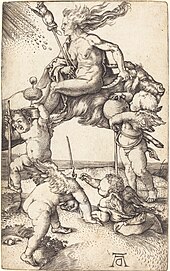
Witches have a long history of being depicted in art, although most of their earliest artistic depictions seem to originate in Early Modern Europe, particularly the Medieval and Renaissance periods. Many scholars attribute their manifestation in art as inspired by texts such as Canon Episcopi, a demonology-centered work of literature, and Malleus Maleficarum, a "witch-craze" manual published in 1487, by Heinrich Kramer and Jacob Sprenger.
See also
- Aradia, or the Gospel of the Witches – 1899 book by Charles Godfrey Leland
- Feminist interpretations of witch trials in the early modern period
- Flying ointment – Hallucinogenic salve used in the practice of witchcraft
- History of goetia– Magical practice involving evocation of demons
- Kitchen witch – Witch doll
- Witches' Sabbath – Gathering of those believed to practice witchcraft
Notes
- ^ An extract from Hutton's The Witch covering this topic can be read online at https://yalebooksblog.co.uk/2017/07/31/five-characteristics-of-a-witch-an-extract-by-ronald-hutton/ [1]: 3-4
- ^ "If we analyze the principles of thought on which magic is based, they will probably be found to resolve themselves into two: first, that like produces like, or that an effect resembles its cause; and, second, that things which have once been in contact with each other continue to act on each other at a distance after the physical contact has been severed. The former principle may be called the Law of Similarity, the latter the Law of Contact or Contagion. From the first of these principles, namely the Law of Similarity, the magician infers that he can produce any effect he desires merely by imitating it: from the second he infers that whatever he does to a material object will affect equally the person with whom the object was once in contact, whether it formed part of his body or not."[34]
- ^ There is some discrepancy between translations; compare the displayed text with that of the Catholic Encyclopedia article on Witchcraft Archived 2021-02-11 at the Wayback Machine (accessed 31 March 2006)[69] and the L. W. King translation Archived 2007-09-16 at the Wayback Machine (accessed 31 March 2006).
References
- ^ a b c d e f g h i j k l m n o p q r s t u v w x y z aa ab ac ad ae af ag ah ai aj ak al am an ao ap aq ar as at au av aw Hutton, Ronald (2017). The Witch: A History of Fear, from Ancient Times to the Present. Yale University Press.
- ^ ISBN 978-0297002208.
- ^ Russell, Jeffrey Burton; Lewis, Ioan M. (21 June 2023). "Witchcraft". Encyclopedia Britannica. Archived from the original on 28 June 2023. Retrieved 28 July 2023.
Although defined differently in disparate historical and cultural contexts, witchcraft has often been seen, especially in the West, as the work of crones who meet secretly at night, indulge in cannibalism and orgiastic rites with the Devil, or Satan, and perform black magic. Witchcraft thus defined exists more in the imagination of contemporaries than in any objective reality. Yet this stereotype has a long history and has constituted for many cultures a viable explanation of evil in the world.
- ^ from the original on 18 July 2021. Retrieved 28 April 2021.
- ^ ISBN 978-0806125121. Archivedfrom the original on 23 April 2017. Retrieved 8 October 2010.
- ISBN 978-1785330865.
- ^ ISBN 978-1-85285-297-9.
- ISBN 0674270266.
- ^ a b c
Ehrenreich, Barbara; English, Deirdre (2010). Witches, Midwives & Nurses: A History of Women Healers (Second ed.). New York: ISBN 978-1558616905.
- ^ Demetrio, F. R. (1988). Philippine Studies Vol. 36, No. 3: Shamans, Witches and Philippine Society, pp. 372-380. Ateneo de Manila University.
- ISBN 978-9715425704. Archivedfrom the original on 26 January 2021. Retrieved 17 September 2020.
- ^ ISBN 978-1-84519-754-4.
- JSTOR 40405642.
- ISBN 978-0791412138.
- ^ Lewis, James (1996). Magical Religion and Modern Witchcraft. SUNY Press. p. 376.
- ^ https://www.ohchr.org/en/special-procedures/ie-albinism/witchcraft-and-human-rights
- ^ ISBN 978-0826486066.
- ^ ISBN 9780470657225.
- ^ a b https://www.jstor.org/stable/42002806 The opposite of witchcraft: Evans-Pritchard and the problem of the person Martin A. Mills The Journal of the Royal Anthropological Institute, Vol. 19, No. 1 (March 2013)
- ISBN 978-0198740292.
- ^ Ankarloo, Bengt and Henningsen, Gustav (1990) Early Modern European Witchcraft: Centres and Peripheries. Oxford: Oxford University Press. pp. 1, 14.
- ^ https://www.nigerianjournalsonline.com/index.php/najp/article/download/1925/1881
- .
- ^ OCLC 515560.
- ^ Harper, Douglas. "witchcraft (n.)". Online Etymology Dictionary. Archived from the original on 5 November 2013. Retrieved 29 October 2013.
- ^ "Home : Oxford English Dictionary". oed.com. Archived from the original on 18 July 2021. Retrieved 18 July 2021.
- ^ "witch". Oxford English Dictionary (Online ed.). Oxford University Press. (Subscription or participating institution membership required.)
- ^ "hag (n.)". Online Etymology Dictionary.
- ^ "Definition of WITCH". www.merriam-webster.com. Retrieved 12 October 2023.
- ^ a b Levack, Brian (2013). The Oxford Handbook of Witchcraft in Early Modern Europe and Colonial America. Oxford University Press.
- ISBN 978-0801825231.
- ISBN 978-0674182325.
- ISBN 978-0719056567.
- ^ Frazer, James (1922). The Golden Bough. Bartleby.
- ^ Burns, William (2003). Witch Hunts in Europe and America: An Encyclopedia. Bloomsbury Publishing. pp. 141–142.
- ^ Rodney Needham, Primordial Characters, Charlottesville, Va, 1978, 26, 42
- (PDF) from the original on 31 July 2020. Retrieved 26 October 2018.
- JSTOR 125012.
- ^ Pope, J.C. (1968). Homilies of Aelfric: a supplementary collection (Early English Text Society 260). Vol. II. Oxford, England: Oxford University Press. p. 796.
- .
- ISBN 978-1852855550. Archivedfrom the original on 18 July 2021. Retrieved 22 November 2020.
- ISBN 978-0415196123.
- ^ a b Willis, Deborah (2018). Malevolent Nurture: Witch-Hunting and Maternal Power in Early Modern England. Cornell University Press.
- ^ Ole Peter Grell and Robert W. Scribner (2002). Tolerance and Intolerance in the European Reformation. Cambridge University Press. p. 45. "Not all the stereotypes created by elites were capable of popular reception ... The most interesting example concerns cunning folk, whom secular and religious authorities consistently sought to associate with negative stereotypes of superstition or witchcraft. This proved no deterrent to their activities or to the positive evaluation in the popular mind of what they had to offer."
- ^ Scot, Reginald (1584). "Chapter 9". The Discoverie of Witchcraft. Vol. Booke V.
- ^ a b Wilby, Emma (2006) Cunning Folk and Familiar Spirits.
- ^ ISBN 978-9639116191.
- ISBN 978-0873517508.
Supernatural healing of the sort practiced by Inger Roed and Lisbet Nypan, known as signeri, played a role in the vast majority of Norway's 263 documented witch trials. In trial after trial, accused 'witches' came forward and freely testified about their healing methods, telling about the salves they made and the bønner (prayers) they read over them to enhance their potency.
- ^ Hoggard, Brian (2004). "The archaeology of counter-witchcraft and popular magic", in Beyond the Witch Trials: Witchcraft and Magic in Enlightenment Europe, Manchester University Press. p. 167[ISBN missing]
- ^ Pearlman, Jonathan (11 April 2013). "Papua New Guinea urged to halt witchcraft violence after latest 'sorcery' case". The Telegraph. London, England: Telegraph Media Group. Archived from the original on 11 February 2018. Retrieved 5 April 2018.
- ^ "Saudi woman beheaded for 'witchcraft and sorcery'". Edition.cnn.com. 13 December 2011. Archived from the original on 21 May 2020. Retrieved 7 June 2014.
- ^ "Saudi man executed for 'witchcraft and sorcery'". BBC News. Bbc.com. 19 June 2012. Archived from the original on 30 May 2019. Retrieved 7 June 2014.
- ^ di Giovanni, Janine (14 October 2014). "When It Comes to Beheadings, ISIS Has Nothing Over Saudi Arabia". Newsweek. Archived from the original on 16 October 2014. Retrieved 17 October 2014.
- ^ "A Global Issue that Demands Action" (PDF). the Academic Council on the United Nations System (ACUNS) Vienna Liaison Office. 2013. Archived (PDF) from the original on 30 June 2014. Retrieved 7 June 2014.
- ^ Diwan, Mohammed (1 July 2004). "Conflict between State Legal Norms and Norms Underlying Popular Beliefs: Witchcraft in Africa as a Case Study". Duke Journal of Comparative & International Law. 14 (2): 351–388. Archived from the original on 25 February 2021. Retrieved 28 March 2021.
- CiteSeerX 10.1.1.694.6630. Archived from the original(PDF) on 25 April 2012. Retrieved 7 June 2014.
- ^ "Nepal: Witchcraft as a Superstition and a form of violence against women in Nepal". Humanrights.asia. Asian Human Rights Commission. Archived from the original on 25 June 2014. Retrieved 7 June 2014.
- S2CID 146650565.
- ^ "World Report on Violence and Health" (PDF). World Health Organization. Archived (PDF) from the original on 24 January 2014. Retrieved 7 June 2014.
- ^ Bussien, Nathaly et al. 2011. Breaking the spell: Responding to witchcraft accusations against children, in New Issues in refugee Research (197). Geneva, Switzerland: UNHCR
- ^ Cimpric, Aleksandra 2010. Children accused of witchcraft, An anthropological study of contemporary practices in Africa. Dakar, Senegal: UNICEF WCARO
- ^ Molina, Javier Aguilar 2006. "The Invention of Child Witches in the Democratic Republic of Congo, Social cleansing, religious commerce and the difficulties of being a parent in an urban culture". London: Save the Children
- ^ Human Rights Watch 2006. Children in the DRC. Human Rights Watch report, 18 (2)
- ^ "Witchcraft murder: Couple jailed for Kristy Bamu killing". BBC News. Bbc.co.uk. 5 March 2012. Archived from the original on 8 April 2014. Retrieved 8 June 2014.
- ^ Dangerfield, Andy (1 March 2012). "Government urged to tackle 'witchcraft belief' child abuse". BBC News. Bbc.co.uk. Archived from the original on 8 October 2014. Retrieved 8 June 2014.
- ^ a b Reiner (1995), p. 97.
- ^ a b c d e f g Abusch (2002).
- ^ The Oldest Code of Laws in the World By C.H.W. Johns https://www.gutenberg.org/files/17150/17150-h/17150-h.htm
- ^ a b "Catholic Encyclopedia: Witchcraft". Newadvent.org. 1 October 1912. Archived from the original on 11 February 2021. Retrieved 31 October 2013.
- ISBN 978-1628370829.
- ^ ISBN 978-1438448497.
- ^ Sanhedrin 67b
- ^ Green, Kayla. "The Golem in the Attic". Archived 25 August 2017 at the Wayback Machine Moment. 1 February 2011. 25 August 2017.
- ^ Bilefsky, Dan (10 May 2009). "Hard Times Give New Life to Prague's Golem". The New York Times. Archived from the original on 9 May 2013. Retrieved 19 March 2013.
According to Czech legend, the Golem was fashioned from clay and brought to life by a rabbi to protect Prague's 16th-century ghetto from persecution, and is said to be called forth in times of crisis. True to form, he is once again experiencing a revival, and in this commercial age, has spawned a one-monster industry.
- ^ Russell, Jeffrey Burton. "Witchcraft". Britannica.com. Archived from the original on 10 May 2013. Retrieved 29 June 2013.
- ^ Gibbons, Jenny (1998) "Recent Developments in the Study of the Great European Witch Hunt" in The Pomegranate Archived 2009-01-26 at the Wayback Machine #5, Lammas 1998.
- ISBN 978-0062500496.
- ISBN 978-0862412319.
- ISBN 978-1298711960.)
{{cite book}}: CS1 maint: location missing publisher (link - ^ Sinclair, George (1871). Satan's Invisible World Discovered. Edinburgh.
{{cite book}}: CS1 maint: location missing publisher (link) - ISBN 978-1615303434. Archivedfrom the original on 26 January 2021. Retrieved 29 June 2013.
- ISBN 978-0485890037.
In 1538 the Spanish Inquisition cautioned its members not to believe everything the Malleus said, even when it presented apparently firm evidence.
- ^ "History of Witches". History.com. 20 October 2020. Retrieved 26 October 2021.
- ISBN 978-0860787150. Archivedfrom the original on 18 July 2021. Retrieved 25 August 2020.
- ISBN 978-0691166285. Archivedfrom the original on 18 July 2021. Retrieved 4 May 2021.
- ^ Savage-Smith, Emilie, ed. Magic and divination in early Islam. Routledge, 2021. p. 87
- ^ Rose, Elliot, A Razor for a Goat, University of Toronto Press, 1962.
- Blackwell Publishers, 1993.
- ^ a b Hutton, Ronald, The Triumph of the Moon: A History of Modern Pagan Witchcraft, Oxford University Press, 1999.[ISBN missing]
- Llewellyn Publications, 1991.[ISBN missing]
- ^ Valiente, D., The Rebirth of Witchcraft, London: Robert Hale, pp. 35–62, 1989.[ISBN missing]
- ^ PMID 36417350.
- ^ "Witchcraft beliefs are widespread, highly variable around the world". Public Library of Science via phys.org. Retrieved 17 December 2022.
- ISBN 978-1848880610.[page needed]
- ^ Igwe, Leo (September–October 2020). "Accused Witches Burned, Killed in Nigeria". Skeptical Inquirer. Amherst, New York: Center for Inquiry.
- ISBN 0813917034.
- ^ "The dangers of witchcraft". Archived from the original on 12 March 2010. Retrieved 26 March 2010.
- ^ "Kolwezi: Accused of witchcraft by parents and churches, children in the Democratic Republic of Congo are being rescued by Christian activists". Christianity Today. September 2009. Archived from the original on 14 November 2011. Retrieved 14 October 2011.
- ^ Whitaker, Kati (September 2012). "Ghana witch camps: Widows' lives in exile". BBC News. BBC. Archived from the original on 20 October 2018. Retrieved 1 September 2012.
- ^ Kanina, Wangui (21 May 2008). "Mob burns to death 11 Kenyan "witches"". Reuters. Archived from the original on 20 June 2017. Retrieved 15 September 2016.
- ^ Byrne, Carrie 2011. Hunting the vulnerable: Witchcraft and the law in Malawi; Consultancy Africa Intelligence (16 June):
- ^ "Stepping Stones Nigeria 2007. Supporting Victims of Witchcraft Abuse and Street Children in Nigeria". humantrafficking.org. Archived from the original on 17 October 2012.
- ISBN 978-0226893983(pbk.).
- ISBN 978-0-86486-556-4.
- ^ Kielburger, Craig; Kielburger, Marc (18 February 2008). "HIV in Africa: Distinguishing disease from witchcraft". Toronto Star. Toronto, Ontario, Canada: Toronto Star Newspapers Ltd. Archived from the original on 19 October 2017. Retrieved 18 September 2017.
- ^ "Ebola outbreak: 'Witchcraft' hampering treatment, says doctor". BBC News. London: BBC. 2 August 2014. Archived from the original on 18 July 2021. Retrieved 22 June 2018.
citing a doctor from Médecins Sans Frontières: 'A widespread belief in witchcraft is hampering efforts to halt the Ebola virus from spreading'
- ^ "Social stigma as an epidemiological determinant for leprosy elimination in Cameroon". Journal of Public Health in Africa. Archived from the original on 31 July 2017. Retrieved 27 August 2014.
- ^ Akosua, Adu (3 September 2014). "Ebola: Human Rights Group Warns Disease Is Not Caused By Witchcraft". The Ghana-Italy News. Archived from the original on 3 September 2014. Retrieved 31 October 2017.
- ^ .
- ^ a b c Witchcraft and Magic: Contemporary North America; Edited by HELEN A. BERGER; Copyright: 2005; Published by: University of Pennsylvania Press; https://www.jstor.org/stable/j.ctt3fh7kf
- ^ Kilpatrick, Alan (1998). The Night Has a Naked Soul - Witchcraft and Sorcery Among the Western Cherokee. Syracuse University Press.
- PMID 22069814.
To the Hopis, witches or evil-hearted persons deliberately try to destroy social harmony by sowing discontent, doubt, and criticism through evil gossip as well as by actively combating medicine men. ... Admitting [he practiced witchcraft] could cost him his life and occult power
- ISBN 978-0803291164.
- ^ Wallace, Dale Lancaster (January 2015). "Rethinking religion, magic and witchcraft in South Africa: From colonial coherence to postcolonial conundrum". Journal for the Study of Religion. 28 (1): 23–51. Retrieved 15 September 2023 – via Acaemdia.edu.
- S2CID 240055921.
- S2CID 23596915.
- ^ a b "Diabolism in the New World". ABCCLIO. 2005. Archived from the original on 18 July 2021. Retrieved 10 February 2013.
- JSTOR 2517981.
- JSTOR 645632.
- ^ Lavrin, Asunción. Sexuality & Marriage in Colonial Latin America. Reprint ed. Lincoln: University of Nebraska Press, 1992, p. 192.[ISBN missing]
- ^ Lewis, Laura A. Hall of mirrors: power, witchcraft, and caste in colonial Mexico. Durham, N.C.:Duke University Press, 2003, p. 13.[ISBN missing]
- ^ (in Portuguese) João Ribeiro Júnior, O Que é Magia, pp. 48–49, Ed. Abril Cultural.[ISBN missing]
- ^ ISBN 978-0313343391.
- S2CID 27804741.
- ^ a b c d Dickie, Matthew (2003). Magic and Magicians in the Greco-Roman World. Routledge. pp. 138–142.
- ^ ISBN 978-0728602304. Archivedfrom the original on 8 August 2016. Retrieved 27 February 2016.
- ^ a b William Wyatt Gill (1892). "Wizards". The south Pacific and New Guinea, past and present; with notes on the Hervey group, an illustrative song and various myths. Sydney: Charles Potter, Government Printer.
- ^ Woman suspected of witchcraft burned alive Archived 2009-04-29 at the Wayback Machine CNN.com. January 8, 2009.
- ^ "Papua New Guinea's 'Sorcery Refugees': Women Accused of Witchcraft Flee Homes to Escape Violence Archived 2017-03-20 at the Wayback Machine". Vice News. January 6, 2015.
- ^ a b c Lawrence, Salmah Eva-Lina (2015). "Witchcraft, Sorcery, Violence: Matrilineal and Decolonial Reflections". In Forsyth, Miranda; Eves, Richard (eds.). Talking it Through: Responses to Sorcery and Witchcraft Beliefs and Practices in Melanesia. Canberra, Australia: ANU Press.
- S2CID 191376143.
- from the original on 18 May 2021. Retrieved 18 May 2021.
Works cited
- Abusch, Tzvi (2002). Mesopotamian Witchcraft: Toward a History and Understanding of Babylonian Witchcraft Beliefs and Literature. Brill Styx. ISBN 9789004123878.
- Reiner, E. (1995). Astral magic in Babylonia. Philadelphia: American Philosophical Society. ISBN 978-0871698544.
Further reading
This 'further reading' section may need cleanup. (March 2024) |
- Bristol, J. C. (2007). Christians, Blasphemers, and Witches: Afro-Mexican Ritual Practice in the Seventeenth Century. Albuquerque: University of New Mexico Press.
- Epstein, I. (2008). The Greenwood Encyclopedia of Children's Issues Worldwide. Greenwood Press.
- ISBN 978-0226296937.
- Gittins, Anthony J. (1987). "Mende Religion". Studia Instituti Anthropos. 41. Nettetal: Steyler Verlag.
- Hutton, R. (2006). Witches, Druids and King Arthur. Bloomsbury Academic. ISBN 978-1852855550
- Janzen, John M.; MacGaffey, Wyatt (1974). "An Anthology of Kongo Religion: Primary Texts from Lower Zaïre". University of Kansas Publications in Anthropology (5). Lawrence.
- Kent, Elizabeth. "Masculinity and Male Witches in Old and New England." History Workshop 60 (2005): 69–92.
- Lima, R. (2005). Stages of Evil: Occultism in Western Theater and Drama. University Press of Kentucky. ISBN 978-0813123622.
- Murray, D. (2013). Matter, Magic, and Spirit: Representing Indian and African American Belief. University of Pennsylvania Press.
- Narby, J. (1998). The Cosmic Serpent: DNA and the Origins of Knowledge. TarcherPerigee.
- Pentikainen, J (1978). "Marina Takalo as an Individual in Oral Repertoire and World View. An Anthropological study of Marina Takalo's Life History". F. F. Communications Turku. 93 (219): 58–76. INIST 12698358.
- Pentikainen, Juha. "The Supernatural Experience." F. Jstor. 26 February 2007.
- Rasbold, K. (2019). Crossroads of Conjure: The Roots and Practices of Granny Magic, Hoodoo, Brujería, and Curanderismo. Llewellyn Worldwide.
- Ruickbie, Leo (2004) Witchcraft out of the Shadows: A History, London, Robert Hale.[ISBN missing]
- Williams, Howard (1865). The Superstitions of Witchcraft. London: Longman, Green, Longman, Roberts, & Green – via Project Gutenberg.
External links
- Witchcraft on In Our Time at the BBC
- Kabbalah On Witchcraft – A Jewish view (Audio) chabad.org
